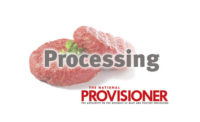Slowly but Surely
by Richard Mitchell
Although case-ready red meat is not growing as fast as some predicted it would years ago, it is continuing to grow — indicating the concept is here to stay.
Case-ready packaging is leaving an increasingly larger footprint in retailers’ meat and poultry aisles. Spurred by growing interest in food safety, reducing backroom costs, cutting shrinkage, and keeping cases continually stocked with meat and poultry, many merchants are expanding their case-ready offerings.
In turn, packaging suppliers are developing new designs and technologies in an effort to grab larger slices of the expanding market.
“When you talk to meat-case managers you hear about the same problems time and again, including not having a lot of labor available to them, or products that can’t be sold because the meat or poultry is past the date code,” says Lin Lauve, market research manager for MN-based processor Cargill Meat Solutions. “It is leading supermarkets to move to case-ready for all types of meat.”
“When you talk to meat-case managers you hear about the same problems time and again, including not having a lot of labor available to them, or products that can’t be sold because the meat or poultry is past the date code,” says Lin Lauve, market research manager for MN-based processor Cargill Meat Solutions. “It is leading supermarkets to move to case-ready for all types of meat.”
Wal-Mart Stores Inc., operator of the largest grocery chain in the United States, began offering all its meat and poultry in case-ready packaging in 2001. Bentonville, AR-based Wal-Mart distributes products in modified atmosphere packaging (MAP) trays in more than 1,430 stores.
“The leak-proof package provides enhanced quality control, and lets us keep meat products constantly in stock,” a Wal-Mart spokesperson says.
Cargill has been using case-ready packaging for more than a decade, including MAP for its Honeysuckle White and Shady Brook Farms turkey lines. The MAP tray contains a combination of oxygen, carbon dioxide, and nitrogen that keeps the environment sterile for a longer shelf life, says Lorena Rull, case-ready brand manager for Cargill’s turkey division. An overwrap seal protects the contents from leakage, she adds.
Cargill has been using case-ready packaging for more than a decade, including MAP for its Honeysuckle White and Shady Brook Farms turkey lines. The MAP tray contains a combination of oxygen, carbon dioxide, and nitrogen that keeps the environment sterile for a longer shelf life, says Lorena Rull, case-ready brand manager for Cargill’s turkey division. An overwrap seal protects the contents from leakage, she adds.
“Packaging at the supermarket is getting more competitive,” Rull notes. “So there are more upgrades in case-ready, just as packaging is being upgraded in the rest of the store.”
Packaging enhancement
Among the packaging companies enhancing their lines is Fort Lauderdale, FL-based Linpac Plastics, which has developed a MAP called SMARTsize designed to optimize space in corrugated shipping boxes or reusable totes. Each layer of a shipping box holds six SMARTsize packages, compared to four items using traditional packaging, reports Darin Gregg, Linpac North American marketing manager. The design enables retailers to fit more products in a case while reducing per-package transportation costs, he adds.
Linpac also is working to develop a hermetically sealed top-lidded package in which the profile of the leak-proof package will be above the top of the tray to give consumers a better view of meat and poultry. The package also will be shaped to take up less space in retail and shipping cases, Gregg says.
Such designs are intended to create further interest in case-ready products.
“It is a certainty that case-ready will increase in popularity and penetration,” he notes.
“It is a certainty that case-ready will increase in popularity and penetration,” he notes.
Indeed, Richmond, VA-based Ukrop’s Super Markets Inc., a chain of 29 grocery stores located in central Virginia, has steadily grown its case-ready stock over the past several years and now offers 95 percent of its meat and poultry in case-ready packages, says Alan Warren, director of meat and seafood. Ukrop’s does its own cutting in a central facility in Richmond, and ships products daily to its stores. Packaging includes a high-oxygen MAP container with overwrap protection in gas-flush barrier bags.
“Case-ready provides greater quality control, fewer out of stocks and better freshness,” Warren says.
“Case-ready provides greater quality control, fewer out of stocks and better freshness,” Warren says.
By eliminating back-room cutting, retailers avoid the safety and sanitation issues associated with food preparation. Keeping supplies of case-ready meat and poultry on hand also enables retailers to fill cases when desired without relying on the availability of butchers. And by selling products in low-oxygen packages — which often have a shelf life of between 21 to 30 days, depending on the product — and high-oxygen packages — with a typical shelf life of between 10 and 15 days — retailers can display meat and poultry longer and thus reduce shrinkage. Store-cut meat typically has a three-day shelf life.
Pactiv Corp., a Lake Forest, IL-based supplier, is marketing a zero-oxygen package that keeps red meat fresh for nearly a month, says Marty Watson, national sales manager. Pactiv’s ActiveTech technology is designed to enable retailers to extend the shelf life of products in a single bag or multipack while using familiar packaging. The longer distribution time also improves inventory management and allows firms to service customers throughout the country from a single centralized facility, he adds.
In March 2002, Pactiv rolled out its R3 technology that provides more stable color for whole-muscle beef. While such low-oxygen packaging costs about 3-to-7 cents more a pound, users often realize overall cost savings because of reduced shrinkage, fewer out-of-stock items, and decreased labor expenses, Watson says.
Another leading packaging supplier, Duncan, SC-based Cryovac/Sealed Air Corp., is marketing its recently developed LID550P film that is intended to support meat shelf life of up to 21 days, says Phil Ryan, general manager of case-ready products for Cryovac North America.
The LID550P has an oxygen barrier layer to maintain the gas mixture, and hermetically seals to the preformed barrier foam tray during the packaging process. The lidstock and tray combination, together with vacuum and gas flushing, is designed to create a low-oxygen modified atmosphere that prolongs the freshness of the product during storage and distribution. Retail meat personnel peel away the barrier portion before putting the package in the retail case to expose a breathable layer that allows air to reenter the package and bloom the meat.
Among the processors leveraging Cryovac technology is Smithfield, VA-based Smithfield Packing Co., a unit of Smithfield Foods. Half of Smithfield’s branded retail products already are case-ready, and the amount will increase over the next several years, says Joe Weber, Smithfield Packing vice president of fresh pork and international sales. Smithfield was scheduled to use case-ready packaging for a line of marinated beef and turkey that was set for release earlier this year.
Overcoming hurdles
Yet, despite such activity, some analysts say many retailers are taking longer than expected to embrace case-ready. Among the hurdles is an inability by some merchants to accurately compare the cost differences between cutting meat themselves and converting to case-ready packaging.
Many retailers also are reluctant to make changes that do not guarantee cost savings, and eliminating in-store meat cutters remains a sensitive labor issue. Some merchants also want to maintain in-store cutting to differentiate themselves from their case-ready competitors, such as Wal-Mart.
“Over time, retailers’ demand for case-ready will increase, and the cost on the supplier side will go down,” Weber says. “Then it will be standard within our industry. But that still may take ten or fifteen years.”
Among the grocers slow to embrace case-ready is Boulder, CO-based Wild Oats Markets Inc., which operates 101 natural organic food markets in 25 states and British Columbia. Because the company’s full-service meat department is integral to its image, there is little incentive to change methods, says Paul Gingerich, vice president of meat, seafood, and foodservice.
“We’re as close to the old-fashioned butcher style as you can get,” Gingerich notes. “The concept of a fresh butcher is our cornerstone.”
Still, Wild Oats started dabbling with the packaging in the past year by rolling out case-ready poultry to about a dozen of its prototype stores that have self-service cases. The case-ready products are selling “steadily,” and could eventually be added to other locations as the stores are upgraded, “if we find it successful or profitable,” Gingerich says.
To further interest such cautious merchants and consumers in case-ready products, suppliers and processors are creating more customer-friendly packaging. Cryovac, for instance, has anti-fog properties built into its lidstock, which enables film to remain fog-free during refrigerated storage and retail display so consumers always have a full view of the product.
Catelli Brothers, a Collingswood, NJ-based veal and lamb processor, uses bright, “eye-catching” packaging as well as labels that are pre-printed with recipe suggestions, says Chris Douthett, vice president of sales and marketing.
“The goal is to get consumers to try more veal and lamb,” he notes. “Customers will buy veal and lamb at restaurants, but many don’t know what to do with it when it is in its raw state. Having instructions in the packaging could change that.”
Although the processor’s 33 case-ready items only account for about 15 percent of its business, Catelli’s case-ready sales are growing about 20 percent annually, Douthett says.
Although the processor’s 33 case-ready items only account for about 15 percent of its business, Catelli’s case-ready sales are growing about 20 percent annually, Douthett says.
Fueling expansion
Less-popular meat items, such as veal and lamb, are helping to fuel case-ready’s expansion.
“Ground beef was the first to go case-ready, but now we’re seeing more types of meat and poultry put in the [case-ready] packages, including pork, whole-muscle beef products, and value-added items — such as those with marinated and seasoned flavor enhancements,” says Jeff Brown, account executive with Associated Packaging Technologies, a Jupiter, FL-based packaging supplier.
“Ground beef was the first to go case-ready, but now we’re seeing more types of meat and poultry put in the [case-ready] packages, including pork, whole-muscle beef products, and value-added items — such as those with marinated and seasoned flavor enhancements,” says Jeff Brown, account executive with Associated Packaging Technologies, a Jupiter, FL-based packaging supplier.
Associated Packaging is marketing CR-FreshLock, its newest line of case-ready meat trays that are made of a proprietary thermoplastic resin. It uses a MAP system that seals with a wide variety of lidding films. A key feature is an “aggressive” seal that supports sealing speeds of 60 to 70 packs per minute in a clean, sanitary, leak-proof package, Brown notes.
Future case-ready packaging, he predicts, will result from an even greater emphasis on marketing and merchandising and will feature more colors, shapes, decorations, and laminations.
“Case-ready is here to stay,” says Linpac Plastics’ Gregg. “We will see a wide variety of packaging methods that will fit what the individual retailer is trying to accomplish, while serving customer needs.”
Richard Mitchell is a Chicago-area freelance writer.
Supplier sources in this article include:
- Associated Packaging Technologies, phone (877) 414-3656, fax (561) 746-7192, e-mail info@APTechnologies.com, or visit www.APTechnologies.com
- Cryovac/Sealed Air Corp., phone (800) 845-7551, fax (864) 433-2134, e-mail cryovac.mkt@sealedair.com, or visit www.cryovac.com
- Linpac Plastics, phone (954) 492-5481, fax (954) 489-0512, e-mail Darin_Gregg@Linpac.com, or visit www.Linpac.com
- Pactiv Corp., phone (585) 393-5168, fax (585) 393-5172, e-mail mwatson@pactiv.com, or visit www.pactiv.com
- Cryovac/Sealed Air Corp., phone (800) 845-7551, fax (864) 433-2134, e-mail cryovac.mkt@sealedair.com, or visit www.cryovac.com
- Linpac Plastics, phone (954) 492-5481, fax (954) 489-0512, e-mail Darin_Gregg@Linpac.com, or visit www.Linpac.com
- Pactiv Corp., phone (585) 393-5168, fax (585) 393-5172, e-mail mwatson@pactiv.com, or visit www.pactiv.com


Report Abusive Comment